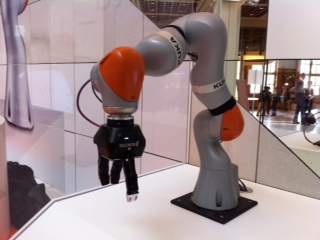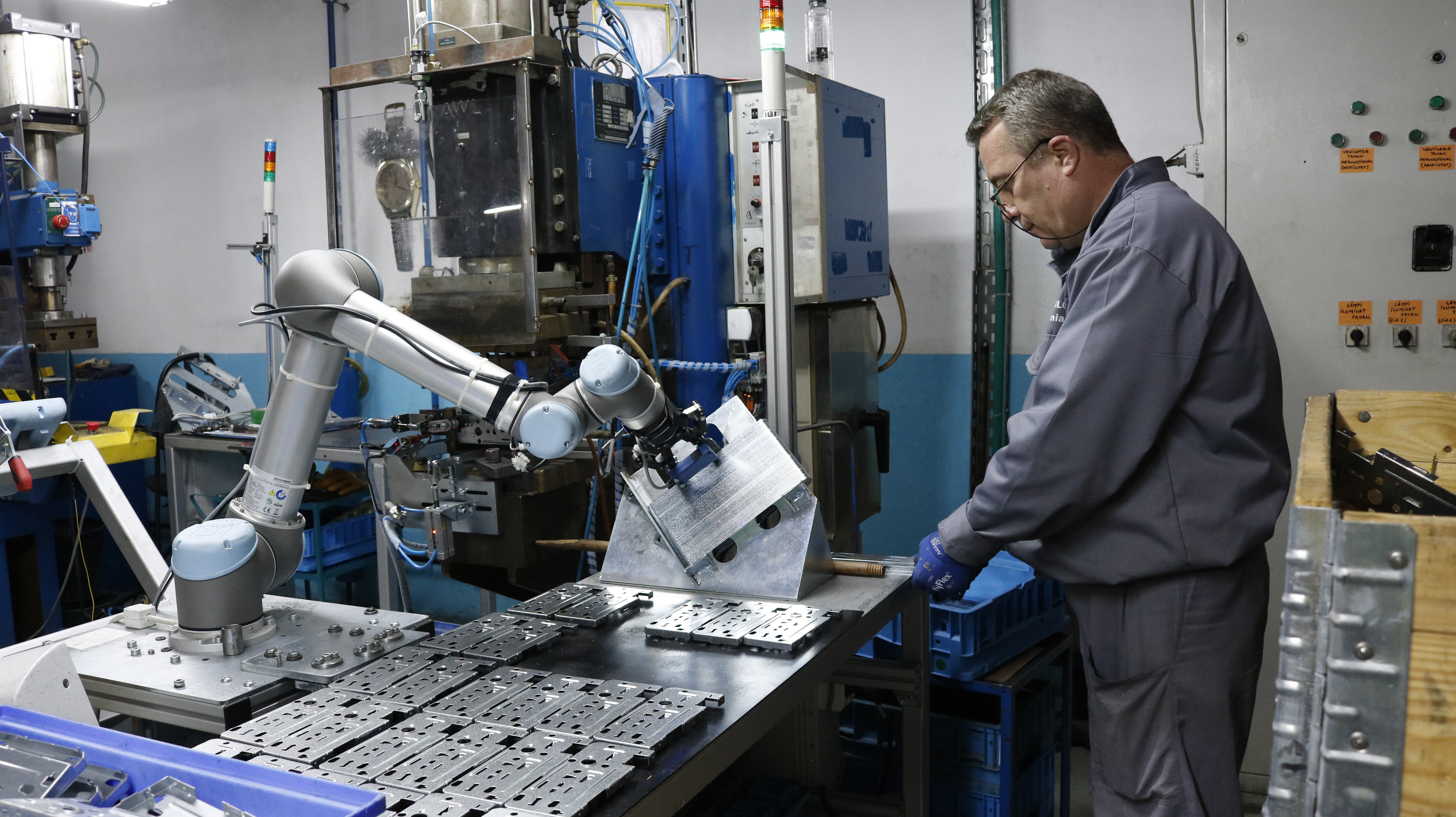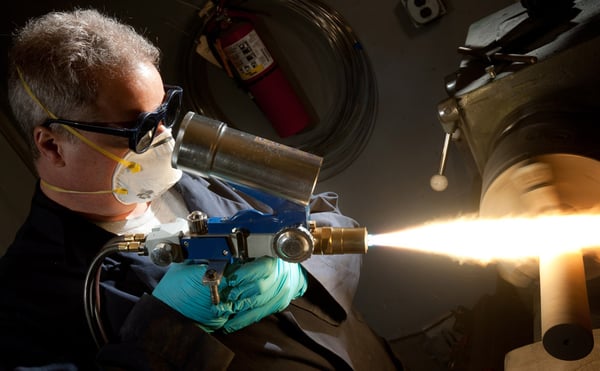What are the Present Safety Requirements for Collaborative Robots?
 Upgrading the standards to include collaborative robots allowed certain, especially smaller robots, to be unchained from the factory floor where they were previously caged for safety reasons and allowed to be mobile. This means that they can be brought out into small and medium sized workshops where they can work alongside humans, using the full potential of their hardware and software improvements and expanding their market potential along the way. This is a great step towards efficient industrial automation for these small and medium sized firms.
Upgrading the standards to include collaborative robots allowed certain, especially smaller robots, to be unchained from the factory floor where they were previously caged for safety reasons and allowed to be mobile. This means that they can be brought out into small and medium sized workshops where they can work alongside humans, using the full potential of their hardware and software improvements and expanding their market potential along the way. This is a great step towards efficient industrial automation for these small and medium sized firms.
Generally when talking about collaborative robots, they can operate autonomously when there is nobody in their safeguarded workspace, must execute a protective stop when a human enters their safeguarded space and then automatic operation can resume when the human is one again outside of their safeguarded workspace. People or operators may interact with the robot and people and robots can move simultaneously around the collaborative workspace. Remembering that a collaborative workspace is usually broader than the safeguarded space, so long as the new standards are applied. These standards coalesce around four safety criteria for collaborative work. The four criteria are related to:
- Monitored stops
- Controlled Speeds
- Separation Distances
- Power and Force Limits.
If a robot is in automatic mode then a visual indication is required when collaborative operation is selected and active. When the robot is capable of making a monitored stop, this means that the robot drive system will have a built-in safety to ensure speed and/or torque is limited to a safe value. With this capability, the robot controller software and hardware have a safety-rated ability to limit the robots range of motion. Hard stops, therefore, are no longer mandatory on new robots and controllers that have this ability. When there is a loss of communications the robot must also perform a protective stop. To which only the power to the manipulator motor is disconnected. No recovery procedure is necessary, as you only need to restore motor power to recover from a protective stop.
Safety
These robots are considered collaborative because of the concept of the programmable safety  control which is embedded in the robot controller and which is separate programming from application programming, since it entails a higher safety recognition factor. This programming can be used to control clearance which allows for the possibility of a setup in a very tight or restricted space, and also reduces hazards and exposure for personnel, which intern can mean a smaller footprint and decreased floor space. Often a feature sought after for small and medium sized businesses.
control which is embedded in the robot controller and which is separate programming from application programming, since it entails a higher safety recognition factor. This programming can be used to control clearance which allows for the possibility of a setup in a very tight or restricted space, and also reduces hazards and exposure for personnel, which intern can mean a smaller footprint and decreased floor space. Often a feature sought after for small and medium sized businesses.
Hand guiding
Hand guiding or teaching and all manual jogging must be done at reduced speeds. Hand‐guiding mode is a mix of Speed/Separation Monitoring and Power/Force Limiting control. Hand-guiding operations or manual mode are allowed with various requirements to ensure safety, for instance, the speed must be below 250 mm/s [9.8 in/sec], a minimum separation distance between itself and an object in its workspace of 20 inches is required and a separate deliberate restart is also required after a protective stop.
Speed
Whenever a robot is performing an operation at high speed, or speeds exceeding 250 mm/s [9.8 in/sec], a manual clearance of 20 inches is always required regardless of the location of the tasks. Robots must also maintain a minimum separation distance between itself and any object in its workspace of 20 inches and not the previous 18 inches at all times. If a violation of the robot's safe workspace will exposed personnel to pinching, crushing or trapping hazard(s) when performing tasks, including teaching or minor servicing then a protective stop must be executed. The speed and separation of the robot must be continuously and dynamically adjusted. Distance and speed monitoring is also called separation monitoring.
Mobility
If a robot is moving then it should be programmed to avoid contact with humans as they enter the collaborative workspace, not just the safeguarded workspace and maintain a minimum separation distance of 18 to 20 inches. If a person is within the minimum separation distance while the robot is moving, the robot should perform a protective stop. The safety distance in this case may be based on the worst anticipated collision according to the varying loads, speeds, and extensions anticipated, but it does not have to be based on the worst possible anticipated collision. This would make smaller safety distances possible depending on the risk assessment. Where contact between the robot and operator may occur, power and force must be limited to inherently safe levels, again according to the risk assessment.
Software
Since collaborative robots are both hardware and software based systems, validating all parts of  the safety function is also a requirement. So the robot system must conform and this includes the pendant which must also conform to the safety standards. This means risk assessments are extremely important and must be tailored to the system and its safety needs. Because of this, integrators are required to provide the risk assessment results to the end-user. Care also needs to be taken to avoid confusion between active and inactive stop devices by providing for appropriate design to prevent a situation when an inactive pendant has an visible Estop and in a panic situation someone might think the Estop functions. Ultimately, the user is responsible for multiple pendants, but systems should be designed to recognize live and non-functional pendants.
the safety function is also a requirement. So the robot system must conform and this includes the pendant which must also conform to the safety standards. This means risk assessments are extremely important and must be tailored to the system and its safety needs. Because of this, integrators are required to provide the risk assessment results to the end-user. Care also needs to be taken to avoid confusion between active and inactive stop devices by providing for appropriate design to prevent a situation when an inactive pendant has an visible Estop and in a panic situation someone might think the Estop functions. Ultimately, the user is responsible for multiple pendants, but systems should be designed to recognize live and non-functional pendants.
Risk assessment
The importance of the risk assessment is why it is critical that the industry develop technical specification, like TS 15066. This technical specification aims to look at the limits for impact forces and pressure points which might lead to an injury in the case of a collision. Values from medical literature, as well as from practical tests on pain tolerance levels are being studied, as well as the methodology for test procedures that could validate that acceptable force and pressure limits are not exceeded. These criteria are especially valuable for the establishment of legal liability and thus reduce implementation worries for manufacturers.
Another interesting note is that using monitored stops provides for longer life for the robot, since not removing power and restarting all the time leads to higher reliability due to reduced cycling of the contacts. Fewer interventions means less exposure to hazards, basically if the robot is preforming protective stops and restarting by itself then the human doesn't have to intervene, so more autonomy for the robot means less direct human contact and fewer chances of injury. The more safety features that can be of loaded onto the robot the safer co-workers will feel when working with them and the more acceptable working with robots will become. So the more autonomous the better.






Leave a comment